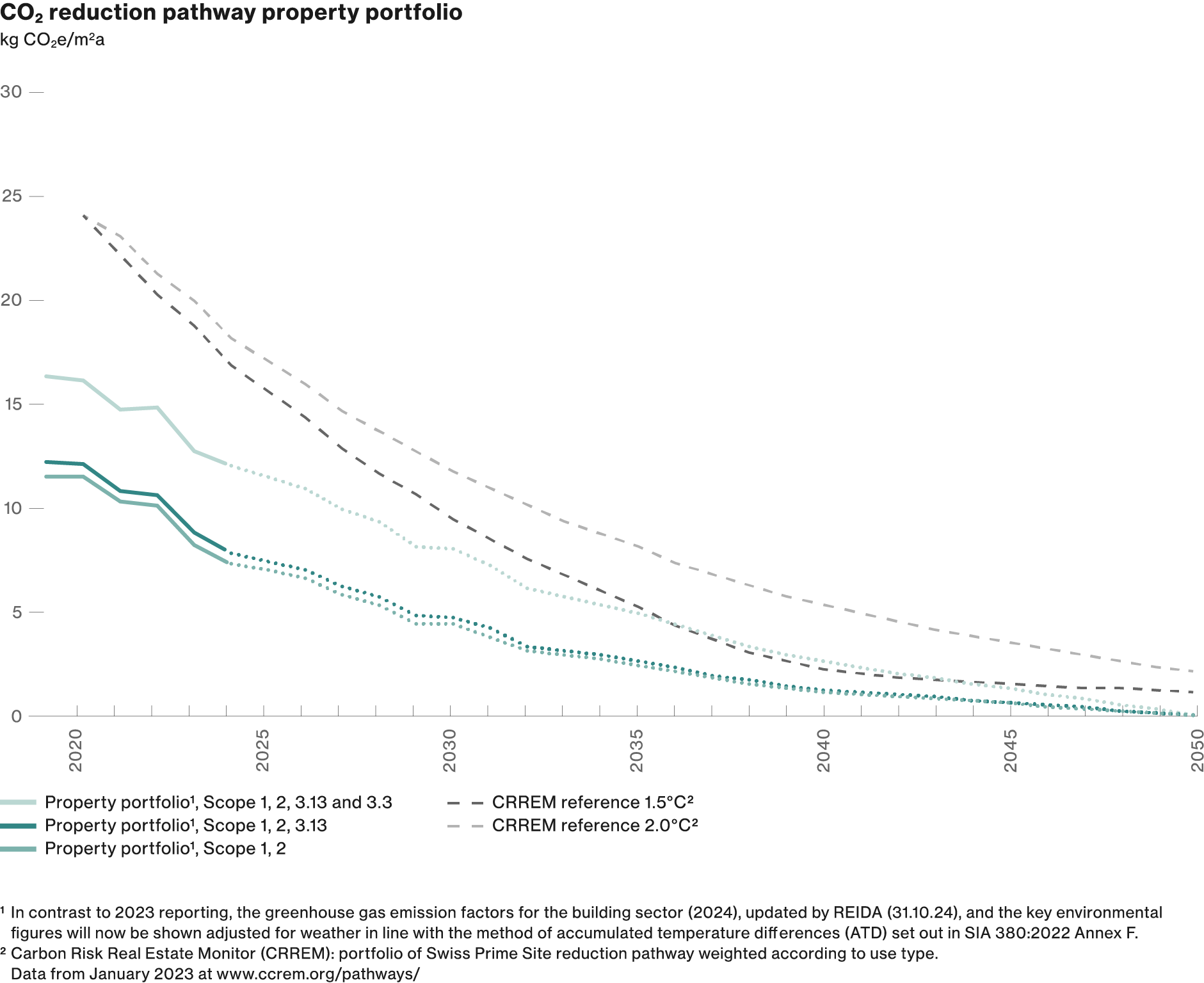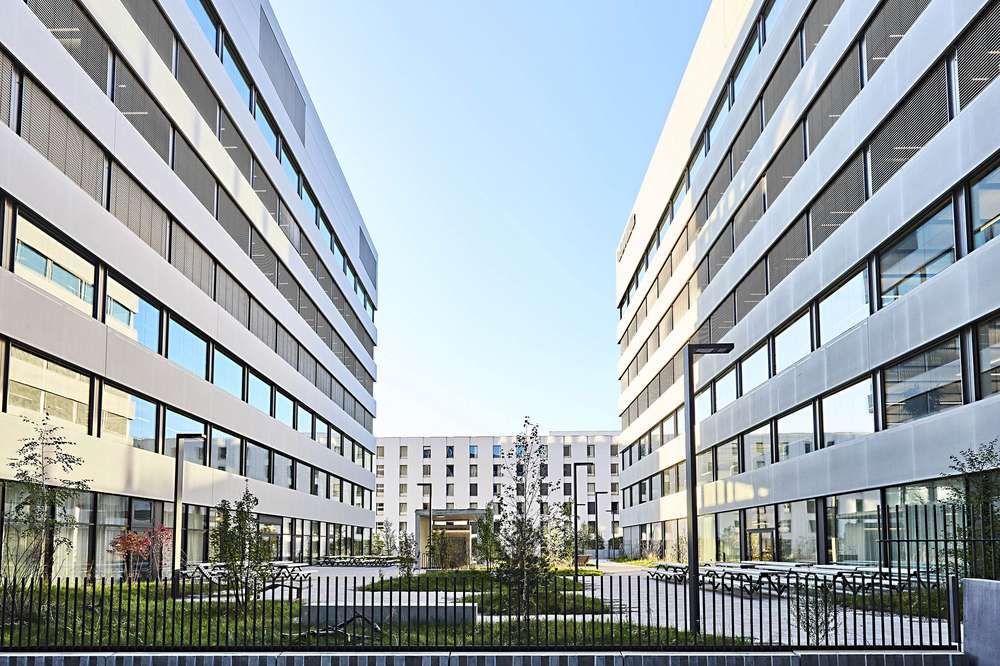Environment (E)
We act in an environmentally conscious and resource-conserving manner - climate neutrality by 2040 and the promotion of the circular economy are at the centre of our activities.
Our material topics
Sustainable development and construction
Certification systems as a frame of reference for the development business
We measure the sustainability performance of our development activities in particular by means of GRESB ratings with the specific Development Benchmark, and with property related certification systems and certificates.
For development projects, the focus is on certification under the Swiss Sustainable Building Standard (SNBS). The application of the SNBS ensures that sustainability is considered throughout the development process. This not only ensures the environmental credentials and economic viability of the building, but also health and safety during the construction process and subsequent operations. The selection of materials and the elimination of hazardous materials play an important role here. If certification under the SNBS is unfeasible – due to the type of use, for instance – other established labels (e.g. Swiss Sustainable Building Council SGNI/DGNB) are used.
Swiss Prime Site Solutions also looks to the SNBS for guidance on sustainable construction. As a rule, development and construction projects are certified under a sustainability standard, where technically and economically viable. For developments on existing properties in the portfolio, the goal is certification under Minergie or the Swiss Sustainable Building Council (DGNB/SGNI).
Sustainable use and sustainable operation
Reference framework for sustainability
The real estate sector is responsible for a significant proportion of CO₂ emissions in Switzerland and throughout theworld. As such, efforts to tackle climate change must look beyond sustainably designed new buildings to include existing properties. The starting points here are strategies for individual properties, maintenance, operation and mobility concepts, and rental contract arrangements that incorporate sustainability aspects. In use, aspects such as quality of life and healthy interior spaces are also important. During the operational phase of properties, we have an influence on sustainability, particularly in relation to maintenance and repair measures and tenants’ improvements, but also in the way we formulate contracts with tenants and suppliers.
Frame of reference for sustainability using GRESB benchmark and certifications
We measure the quality and the sustainability performance of our core processes in portfolio and asset management with both the Global Real Estate Sustainability Benchmark (GRESB) Rating in the Standing Investment category and property-related certification systems and the corresponding certification of existing properties. We apply the BREEAM In-use certification system to the building component of our own existing properties. Various criteria are evaluated as part of the certification, with particular weighting for energy, emissions, health and wellbeing, materials, and durability. In parallel with every certification, a potential analysis is prepared with specific improvement measures. These are fed into the strategies for individual properties and into investment planning and, where viable, implemented with a view to the recertification required every three years. This gives us a uniform frame of reference on sustainability performance in our own property portfolio and allows us to continually optimise our properties and also qualify for our green finance portfolio. Non-certifiable properties include multi-storey car parks/parking spaces and units in condominium ownership that are complex or spatially and technically difficult to delineate.
CO₂ reduction target and reduction pathway
In 2019, we developed a detailed CO2 reduction pathway for our entire property portfolio. Assuming an average annual increase in the portfolio and floor space of 20’000 m2 to date, this path predicted a controllable reduction in relative CO2 emissions (intensity) of at least 75% by 2050 for the approximately 1.6 million square metres of floor space. In 2020, the Sustainability Board of Swiss Prime Site further tightened the reduction target for the real estate portfolio. The new target is to achieve climate neutrality in operations as early as 2040.
Circular economy
Innovative approaches and partnerships for the circular economy
Sustainability and the circular economy are becoming drivers of value and innovation. It is not just a question of minimizing our environmental footprint. Targeted innovations such as urban mining have also come to the fore. The transformation of the business and value creation model and greater cooperation with stakeholders throughout the entire supply chain also gives rise to new business opportunities.
We see ourselves as a driving force in the Swiss real estate sector’s commitment to the circular economy. We are actively committed to Circular Construction Catalyst 2033 (C33), the Swiss coordination body for circular building and the Circular Building Charta. In addition, we are part of the Sustainable Switzerland platform of the NZZ’s Swiss Sustainability Forum.
Objective of the Circular Building Charta 2030
We co-developed the «Circular Building Charta» and we were the first signatory. The Charta is an important guidance tool for promoting the transition to a building industry that uses resources efficiently. The goal is for the Swiss building industry to become a model for circular construction by 2030 through innovation, collaboration and a strong commitment to sustainability.
The Charta aims to halve the use of non-renewable raw materials by 2030. In addition, grey greenhouse gas emissions are to be recorded and reduced, and the circular potential of building projects improved. As a member, we undertake to develop specific plans of action and to implement measures to achieve these goals.
The focus is on keeping construction of new buildings to a minimum (sufficiency) and maintaining the value of buildings in the long term (life cycle perspective). This requires building efficiently with the right – durable – materials. This demands a high level of transparency around environmental impact to enable sound decision-making.
Moreover, an actively managed community promotes knowledge exchange and collaborative learning. This includes the definition of relevant key figures and addressing needs-based questions from the community.
Embedding the circular economy into customer relations and the supply chain
We use our room to manoeuvre to raise awareness of the circular economy and environmental topics among owners, service providers, employees and tenants.
We have laid out a certification strategy in our company-wide Environmental Policy Concept. The goal for all development projects is sustainability certification under SNBS or comparable certification, as well as the Charta ambitions. In this process, we take into account requirements for sustainable procurement and efficient use of materials, such as the use of recycled materials, the selection of regional suppliers, and potential for deconstruction. The set of criteria also includes cross-sectoral topics such as the circular economy, climate adaptation and sufficiency, to which relevant individual criteria are allocated.
Sustainability criteria from certification systems together with the goals and target metrics formulated in the Circular Building Charta enable us to integrate our circular approaches into specifications for architecture competitions, contracts for work and services, and facility management framework agreements very early on, and incorporate them into contractual relationships with tenants and service providers.
Purchaser expertise and the circular approach
We are constantly expanding our expertise relating to the circular economy, and we employ it throughout the Company, both in our own construction and development projects and in our services. In our building activities, we use primary resources and landfill sites efficiently, and reduce CO₂ emissions by focussing on the preservation of the existing building fabric, reducing the materials used, material choice and reducing building waste. During the disposal of waste and the recycling of materials, all relevant legal requirements are met. Wherever possible, waste products are recycled.



